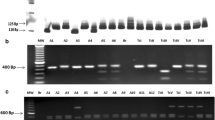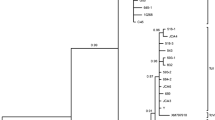Abstract
The genetic variability of 61 Trypanosoma cruzi isolates from 47 chronic chagasic patients of Minas Gerais state was analyzed by random amplified polymorphic DNA polymerase chain reaction (RAPD-PCR) using M13-40, λgt11-F, and L15996 primers. Cluster analysis by unweighted pair group method analysis was applied to RAPD profiles, and cluster analysis used to verify a possible correlation among different clinical forms of the disease from these patients. The T. cruzi isolates showed distinct grouping on tree topology, with the isolates not being possible to establish a correlation to the clinical forms of Chagas’ disease. These data showed that the T. cruzi isolates from these patients would compose a group of populations well correlated genetically.



Similar content being viewed by others
References
Andrade SG (1985) Morphological and behavioral characterization of Trypanosoma cruzi strains. Rev Soc Bras Med Trop 18:39–46
Andrade V, Brodskyn C, Andrade SG (1983) Correlation between isoenzyme patterns and biological behaviour of different strains of Trypanosoma cruzi. Trans R Soc Trop Med Hyg 77:796–799
Añez N, Crisante G, Silva FM, Rojas A, Carrasco H, Umezawa ES, Stolf AMS, Ramirez JL, Teixeira MMG (2004) Predominance of lineage I among Trypanosoma cruzi isolates from Venezuelan patients with different clinical profiles of acute Chagas’ disease. Trop Med Int Health 9:1319–1326
Anonymous (1999) Recommendations from a satellite meeting. Mem Inst Oswaldo Cruz 94:429–432
Apt W, Aguilera X, Arribada A, Gomez L, Miles MA, Widmer G (1987) Epidemiology of Chagas disease in northern Chile: isozyme profiles of Trypanosoma cruzi from domestic and sylvatic transmission cycles and their association with cardiopathy. Am J Trop Med Hyg 37:302–307
Barret TB, Hoff RH, Mott KE, Miles MA, Godfrey DG, Teixeira R, Almeida de Souza JA, Scherlock IA (1980) Epidemiological aspects of three Trypanosoma cruzi zymodemes in Bahia State, Brazil. Trans R Soc Trop Med Hyg 74:84–90
Bosseno MF, Barnabé C, Magallon-Gastélum E, Karsten FL, Ramsey J, Espinoza B, Brenière SF (2002) Predominance of Trypanosoma cruzi lineage I in Mexico. J Clin Microbiol 40:627–632
Brener Z (1977) Intraspecific variations in Trypanosoma cruzi: two types of parasite populations presenting distinct characteristics. In: Pan American Health Organization Scientific Publication No. 347. PAHO, Washington, DC, pp 11–21
Brenière SF, Carrasco R, Revollo S, Aparicio G, Desjeux P, Tibayrenc M (1989) Chagas’ disease in Bolívia: clinical and epidemiological features and zymodemes variability of Trypanosoma cruzi strains isolated from patients. Am J Trop Med Hyg 41:521–529
Carneiro M, Romanha AJ, Chiari E (1991) Biological characterization of Trypanosoma cruzi strains from different zymodemes and schizodemes. Mem Inst Oswaldo Cruz 86:387–393
Carrasco HJ, Frame IA, Valente SA, Miles MA (1996) Genetic exchange as a possible source of genomic diversity in sylvatic populations of Trypanosoma cruzi. Am J Trop Med Hyg 54:418–424
Castro AM, Araújo TC, Jesuíno RS, Soares CM, Luquetti AO (1999) Genetic polymorphism among six Trypanosoma cruzi stocks isolated from chronic chagasic patients. Mem Inst Oswaldo Cruz 94:655–658
Chiari E, Dias JCP, Lana M, Chiari CA (1989) Hemocultures for the parasitological diagnosis of human chronic Chagas’ disease. Rev Soc Bras Med Trop 22:19–23
Dirie MF, Murphy NB, Gardiner PR (1993) DNA fingerprinting of Trypanosoma vivax isolates rapidly identifies intraspecific relationship. J Eukaryot Microbiol 40:132–134
Felsenstein J (1985) Confidence limits on phylogenies: an approach using the bootstrap. Evolution 39:783–791
Fernandes CD, Murta SMF, Cerávolo IP, Krug LP, Vidigal PG, Steindel M, Nardi N, Romanha AJ (1997) Characterization of Trypanosoma cruzi strains isolated from chronic chagasic patients, triatomines and opossums naturally infected from the state of Rio Grande do Sul, Brazil. Mem Inst Oswaldo Cruz 92:343–351
Ferreira AM, Vitor RWA, Carneiro ACAV, Brandão GP, Melo MN (2004) Genetic variability of Brazilian Toxoplasma gondii strains detected by random amplified polymorphic DNA–polymerase chain reaction (RAPD-PCR) and simple sequence repeat anchored–PCR (SSR-PCR). Infect Genet Evol 4:131–142
Gomes RF, Macedo AM, Pena SDJ, Melo MN (1995) Leishmania (Viannia) braziliensis: genetical relationship between strains isolated from different areas of Brazil as revealed by DNA fingerprinting and RAPD. Exp Parasitol 80:681–687
Gomes ML, Macedo AM, Pena SDJ, Chiari E (1998) Genetic relationship between Trypanosoma cruzi strains isolated from chronic chagasic patients in sourthern Brazil as revealed by RAPD and SSR-PCR analysis. Acta Trop 69:99–109
Gomes ML, Toledo MJO, Nakamura CV, Bittencourt NLR, Chiari E, Marques-Araújo S (2003) Trypanosoma cruzi: genetic group with peculiar biochemical and biological behavior. Mem Inst Oswaldo Cruz 98:649–654
Lana M, Chiari CA, Chiari E, Morel CM, Gonçalves AM, Romanha AJ (1996) Characterization of two isolates of Trypanosoma cruzi obtained from the patient Berenice, the first human case of Chagas’ disease described by Carlos Chagas in 1909. Parasitol Res 82:257–260
Lewicka K, Breniere-Campana SF, Barnabe C, Deedt JP,Tibayrenc M (1995) An isoenzyme survey of Trypanosoma cruzi genetic variability in sylvatic cycles from French Guiana. Exp Parasitol 81:20–28
López-Olmos V, Pérez-Nasser N, Pinero D, Ortega E, Hernandez R, Espinoza B (1998) Biological characterization and genetic diversity of Mexican isolates of Trypanosoma cruzi. Acta Trop 69:239–254
Macedo AM, Martins MS, Chiari E, Pena SDJ (1992) DNA fingerprinting of Trypanosoma cruzi: a new tool for characterization of strains and clones. Mol Biochem Parasitol 55:147–154
Martínez-Díaz RA, Escario JA, Nogal-Ruiz JJ, Gómez-Barrio A (2001) Relationship between biological behaviour and randomly amplified polymorphic DNA profile of Trypanosoma cruzi strains. Mem Inst Oswaldo Cruz 96:251–256
Miles MA, Toye PJ, Oswaldo SC, Godfrey DC (1977) The identification by isoenzyme patterns of two distinct strain-groups of Trypanosoma cruzi, circulating independently in a rural area of Brazil. Trans R Soc Trop Med Hyg 71:217–225
Morel C, Chiari E, Plessman CE, Mattei DM, Romanha AJ, Simpson L (1980) Strains and clones of Trypanosoma cruzi can be characterized by pattern of restriction endonuclease products of kinetoplast DNA minicircles. Proc Natl Acad Sci U S A 77:6810–6814
Oliveira RP, Macedo AM, Chiari E, Pena SDJ (1997) An alternative approach to evaluating the intraspecific genetic variability of parasites. Parasitol Today 13:196–200
Pena SDJ, Nunes A (1990) DNA-POP and DNA-PATER, two simple computer programs for population studies and paternity analyses with DNA fingerprintings. Fingerpr News 2:7–8
Rojas L, Fraga J, Sariego I (2004) Genetic variabiliy between Trichomonas vaginalis isolates and correlation with clinical presentation. Infect Genet Evol 4:53–58
Santos FR, Pena SDJ, Epplen JT (1993) Genetic and population study of a Y-linked tetranucleotide repeat DNA polymorphism with a simple non-isotopic technique. Hum Genet 90:655–656
Steindel M, Dias-Neto E, Menezes CLP, Romanha AJ, Simpson AJG (1993) Random amplified polymorphic DNA analysis of Trypanosoma cruzi strains. Mol Biochem Parasitol 60:71–80
Tibayrenc M, Ayala FJ (1988) Isoenzyme variability in Trypanosoma cruzi, the agent of Chagas’ disease: genetical, taxonomic and epidemiological significance. Evolution 42:277–292
Tibayrenc M, Ward P, Moya A, Ayala FJ (1986) Natural populations of Trypanosoma cruzi, the agent of Chagas’ disease, have a complex multiclonal structure. Proc Natl Acad Sci U S A 83:115–119
Tibayrenc M, Neubauer K, Barnabé C (1993) Genetic characterization of six parasitic protozoa: parity between random primer DNA typing and multilocus enzyme electrophoresis. Proc Natl Acad Sci U S A 90:1335–1339
Van der Peer Y, Der Wachter R (1994) Treecon for windows: a software package for the construction and drawing of evolutionary trees for the Microsoft Windows environment. Comput Appl Biosci 10:569–570
Veloso VM, Romanha AJ, Lana M, Murta SMF, Carneiro CM, Alves CF, Borges EC, Tafuri WL, Machado-Coelho GLL, Chiari E, Bahia MT (2005) Influence of the long-term Trypanosoma cruzi infection in vertebrate host on the genetic and biological diversity of the parasite. Parasitol Res 96:382–389
Acknowledgements
This work was supported by grants from the Conselho Nacional de Desenvolvimento Científico e Tecnológico (CNPq-Edital Universal/2001), Fundação de Amparo à Pesquisa do Estado de Minas Gerais (FAPEMIG), and a master fellowship of the FAPEMIG. We thank Afonso Costa Viana and Orlando Carlos Magno from the Departamento de Parasitologia, and Jamil Silvano Oliveira from the Departamento de Bioquímica e Imunologia, Instituto de Ciências Biológicas, UFMG for technical assistance.
Author information
Authors and Affiliations
Corresponding author
Rights and permissions
About this article
Cite this article
D’Ávila, D.A., Gontijo, E.D., Lages-Silva, E. et al. Random amplified polymorphic DNA profiles of Trypanosoma cruzi isolates from chagasic patients with different clinical forms. Parasitol Res 98, 455–461 (2006). https://doi.org/10.1007/s00436-005-0043-5
Received:
Accepted:
Published:
Issue Date:
DOI: https://doi.org/10.1007/s00436-005-0043-5




